John Verge
John Verge (1782—1861) was an English architect, builder, pioneer settler in the Colony of New South Wales, who migrated to Australia and pursued his career there. Verge was one of the earliest and the most important architect of the Greek Revival in Australia. He also brought more comprehensive range of Regency style than any contemporary architects. His design indicates the increasing of sophistication compared to previous architect's design.[1]
John Verge | |
|---|---|
| Born | 1782 |
| Died | 9 July 1861 (aged 78–79) Austral Eden, near the Macleay River, New South Wales, Australia |
| Nationality | English; Australian |
| Occupation | Architect |
| Spouse(s) | |
| Children |
|
| Buildings | 39-41 Lower Fort St , Miller’s Point . |
| Design |
|
Life and career
John Verge was born in Christchurch, Hampshire. Many generations of the Verge family had been bricklayers and stonemasons. Verge married to Catherine Bowles at the age of twenty-two and went to London. From 1804 to 1828, he worked in London in the building trade, becoming a man of means. Verge's marriage eventually failed and, in 1828, he migrated to Sydney, New South Wales, Australia, with his son George Philip, intending to take up a land grant.[2] The first land grant in 1829, he took up land on the Williams River, south of Dungog, New South Wales, called Lyndhurst Vale. The second land grant in 1838, he took up land on the Macleay River named Austral Eden. Having insufficient capital to pursue pastoralism, Verge returned to the building industry between 1830 and 1837, fortuitously at a time when the colonial economy was prospering and designers and builders were in high demand. Between 1830 and 1834 was his maximum architectural activities. He was patronised by many of prominent businessmen and colonists. After 1837, his architectural work was decreasing and restricted. Retiring from architectural practice, he settled at Austral Eden, a pastoral property by the Macleay River in northern New South Wales. In 1858, Verge married Mary, 50-year-old daughter of John Alford at Austral Eden. Verge died on 9 July 1861 at the age of 79 in Austral Eden. He was buried as an Anglican in St. Thomas's burial ground in Port Macquarie.[1]
In the 1830s Verge produced a number of fine houses in Sydney's eastern suburbs, notably several of the 'Villas of Woolloomooloo Hill', the spine of elegant villas largely built by the senior civil servants of the colony on a series of land grants that stretched from Darlinghurst Hill to Potts Point. These villas included Rockwall, built for surveyor John Busby, Tusculum for merchant Alexander Brodie Spark for whom Verge also designed Tempe House, and Goderich Lodge, for Thomas Macquoid. Others including Barham and Rose Bank have been attributed to his hand. Further east he built Rose Bay Lodge for James Holt. To the west of the town he built Lyndhurst, for Dr James Bowman, and Toxteth Park for George Allen, in Glebe. Verge is also credited with Elizabeth Bay House, built at adjacent Elizabeth Bay for Alexander Macleay, the Colonial Secretary. It is theorised that Verge largely worked on a plan provided by Macleay, as his business ledger does not denote amounts that would reflect a full commission. John Bibb, an accomplished draftsman employed by Verge, also worked on the project and James Hume from Scotland supervised the building. The relative contributions of Verge, Bibb and Hume are unknown. The house's beautiful oval saloon, with its geometric stair and domed lantern, is likely the most celebrated interior in early Australian architecture.[1]
Verge's work was not confined to Sydney. Bedervale homestead, near Braidwood, built in 1842, was designed by Verge.[3] Aberglasslyn, built for George Hobler near Maitland, NSW, has been attributed to Verge. Like Elizabeth Bay House it never received its intended colonnade, the victim of the crippling colonial depression of the 1840s. Wyoming Cottage, built between 1832-1843, is located in the suburb of that name north of Gosford.[4] The house he built for himself at Austral Eden was unfortunately destroyed by flood in 1864, three years after Verge's death, and no known sketches survive. Most of his papers were also lost in the flood.
Verge's best known work is Camden Park House, built south west of Sydney for John Macarthur, the wool pioneer and successful colonial businessman. As Macarthur was debilitated towards the end of his life with mental illness his son William seemed to have administered much of the building, and is named in Verge's ledger rather than his father. This has caused confusion with some architectural historians as to the actual client.
Main projects
Camden Park, Menangle (1835)
Camden Park House is completed on 1835, a year after John Macarthur, the client death. This house is still occupied by the Macarthur family and become one of the great mansions of Australia. The style of this house is Palladian style with central two-storey block, one-storey wings and extensions at each side. The façade is giving a colonial elegancy sense of looking, where there are white stucco walls, stone porch and window trimming that results a visual excellency of feeling. This colonial house’s floor level is very near to ground level, which gives an air of intimacy, and also the overhanging roof has a secret gutter that avoids the ugly-looking gutter which usually put it in the front façade of the wall.
Denham Court, Ingleburn (1832)
Denham Court which is located in the local government areas of the City of Campbelltown and City of Liverpool placed on south west of the Sydney Central Business District. Originally, this building was a single-storey house but around 1832 to 1833, Captain Richard Brooks as an architect was enlarging this house by adding two-storey wings with two flanking bow-fronted one storey room. This court is regency influenced with trim lines, stucco walls, and the simple shallowly recessed panels projecting porch. Denham Court’s room is 14 feet high with a geometrical stair along the west wall of the house and also there is a large living hall that extending across the width of the house between the bows fronted. The floor in this house is paved with flagstones diagonally with 18 inches square each. Moreover, in the west of this court, there is a Denham Court chapel, which is a mimic of the church at Denham in England. Those churches were designed by John Verge as well with the style of it is Gothic, where mostly this style is taking over the style of every church.
Elizabeth Bay House (1835–1838)
Elizabeth Bay House, which is a historic home, is located in the suburb of Elizabeth Bay in Sydney, New South Wales, and Australia. It is built between 1835 and 1839. It was known as ‘the finest house in the colony’ as well as a home in the Regency style, originally surrounded by a 54-acre garden, but now situated within a densely populated inner city suburb. It shows Verge at his best and worst as a designer. The main elevation is a simple Regency front, whilst the sides, less ambitious but perhaps more pleasing, have large curved bays, running through the two floors. The general impression given by the design is of quietness and good taste, the severely stuccoed walls being relieved only by the somewhat stiff mouldings run in the plaster work and the elaboration of the entrance. The rear of the house is unstudied and lacks the neatness of the other elevations. The interior has some splendid rooms, the stair hall being one of the finest and perhaps the best, of such things in Australian Colonial architecture. Elliptical on plan, the stair and its upper landings sweep completely round the curved walls. The French windows on the northern front give beautiful light and superb views to main apartment. Verge seems to tire and falter when trying to coordinated all the parts into a whole.
Rockwall House, Potts Point (1831–1837)
Rockwall House, which is still well-known, is located at Rockwall Crescent that is the well-preserved Regency house that Verge designed for John Bushby. It is quite close to Tusculum. The Rockwall House shows Verge in his most restrained and pleasing mood, although the columned porch seems to overpower the flanking verandas in scale.
St Scholastica’s College (1831–1900)
St Scholastica’s College, which used to be Toxteth Park George Allen Estate, is located in Avenue Road, Glebe, built in 1831. Toxteth Park was built for George Allen (1800–77). It was a rectangular two-story block with single-story wings, s a stone-flagged veranda on two sides, with the kitchen and servants’ quarters behind. The style of St Scholastica’s College is original structure Old Colonial Georgian (still visible), Second story and tower Victorian Italianate added in the 1870s. Handsome Inter-War Romanesque chapel added in the twenties. It is made of brick. Moreover, it was originally House, then convent and Education.
Partial list of works
The following buildings designed either in part or in full by Verge are listed on various national,[5] state and local government heritage registers:
| Building name | Image | Location | Year completed |
Australian National Heritage List |
NSW State Heritage Register |
Local government register |
Notes |
|---|---|---|---|---|---|---|---|
| Aberglasslyn House | 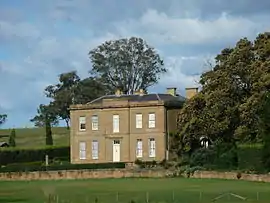 | Aberglasslyn, Maitland | c. 1840 | 00195 | [6] | ||
| Barham | Darlinghurst, Sydney | 1833 | City of Sydney (#I301) | (now SCEGGS Darlinghurst)[7] | |||
| Bedervale | 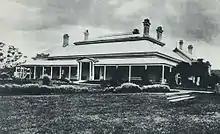 | Braidwood | 1836 | 00017 | [8] | ||
| Brownlow Hill | Cobbitty | 1834 | Alterations attributed to Verge | ||||
| Camden Park Estate | 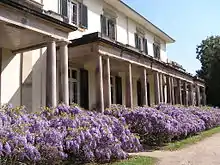 | Menangle | 1835 | 01697 | [9] | ||
| Christ Church | Bong Bong | 1845 | 01383 | [10] | |||
| Church of the Holy Innocents | Rossmore | c. 1848 | Possibly by Verge and John Bibb | ||||
| Denham Court (extensions and chapel) | Ingleburn | 1832–1838 | 00212 | [11] | |||
| Elizabeth Bay House |  | Elizabeth Bay, Sydney | 1835–1838 | 2000 | 00006 | [12][13] | |
| Elizabeth Farm (Extensions, coachhouse and stables) | 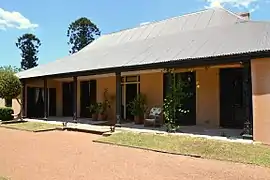 | Parramatta | c. 1830s | 00001 | [14] | ||
| Lietrim (renamed Pine Villa in 1843) | Newtown, Sydney | 1833 | [15] | ||||
| Lyndhurst | 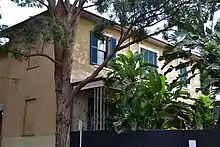 | Glebe, Sydney | 1833–1837 | 00158 | [16] | ||
| Rockwall House |  | Potts Point, Sydney | 1831–1837 | 00020 | [17] | ||
| Salisbury Court |  | Rose Bay, Sydney | 1834 | 00251 | [18] | ||
| St James' Church (vestries at the eastern end framed by two small porticos, and a similar portico as an entrance to the tower) | 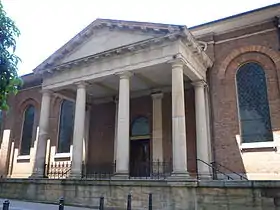 | Queen's Square, Sydney CBD | 1834 | 01703 | [19] | ||
| St Paul's Church | Cobbitty | c. 1840 | |||||
| Tempe House |  | Arncliffe, Sydney | 1836 | 00725 | [20] | ||
| Tomago House | Raymond Terrace | 1843 | Attributed to Verge | ||||
| Toxteth Park | 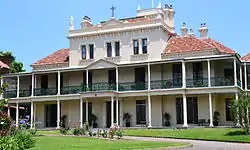 | Glebe, Sydney | 1831 | (now St Scholastica's College)[21] | |||
| Wyoming Cottage | .jpg.webp) | Gosford | 1837–1843 | 00213 | 197 | [22][4] |
See also
- List of buildings designed in full or in part by John Verge
References
- Preston, Harley (1967). "Verge, John (1782–1861)". Australian Dictionary of Biography. 2. Melbourne University Press. ISSN 1833-7538. Retrieved 12 March 2019 – via National Centre of Biography, Australian National University.
- Historic Properties Website:Retrieved 26 June 2009 Archived 6 July 2011 at the Wayback Machine
- "Bedervale Braidwood history". Victoria Royds. Archived from the original on 3 October 2008. Retrieved 14 July 2008.
- Devine, Matt. "WYOMING COTTAGE PACIFIC HIGHWAY, WYOMING, NSW 2250 - Conservation Management Strategy". Cite journal requires
|journal=(help) - The Heritage of Australia, Macmillan Company, 1981, p.97
- "Aberglasslyn". New South Wales State Heritage Register. Office of Environment and Heritage. H00195. Retrieved 18 May 2018.
- "Sydney Church of England Girls Grammar School Group Including Barham, Church Bui, New South Wales Heritage Database (NSW HD) Number HI301". New South Wales Heritage Database. Office of Environment and Heritage. Retrieved 28 June 2020.
- "Bedervale". New South Wales State Heritage Register. Office of Environment and Heritage. H00017. Retrieved 1 June 2018.
- "Camden Park Estate and Belgenny Farm". New South Wales State Heritage Register. Office of Environment and Heritage. H01697. Retrieved 2 June 2018.
- "Christ Church, Churchyard & Cemetery". New South Wales State Heritage Register. Office of Environment and Heritage. H01383. Retrieved 2 June 2018.
- "Denham Court". New South Wales State Heritage Register. Office of Environment and Heritage. H00212. Retrieved 1 June 2018.
- "Elizabeth Bay House". New South Wales State Heritage Register. Office of Environment and Heritage. H00006. Retrieved 18 June 2016.
- "Elizabeth Bay House (Place ID 2000)". Australian Heritage Database. Department of the Environment. 21 March 1978. Retrieved 16 June 2016.
- "Elizabeth Farm". New South Wales State Heritage Register. Office of Environment and Heritage. H00001. Retrieved 1 June 2018.
- Tocal History Notes XV:Retrieved 15 December 2010 Archived 24 July 2011 at the Wayback Machine
- "Lyndhurst". New South Wales State Heritage Register. Office of Environment and Heritage. H00158. Retrieved 13 October 2018.
- "Rockwall". New South Wales State Heritage Register. Office of Environment and Heritage. H00020. Retrieved 13 October 2018.
- "Salisbury Court". New South Wales State Heritage Register. Office of Environment and Heritage. H00251. Retrieved 1 June 2018.
- "St. James' Anglican Church". New South Wales State Heritage Register. Office of Environment and Heritage. H01703. Retrieved 14 October 2018.
- "Tempe House & St Magdalenes Chapel". New South Wales State Heritage Register. Office of Environment and Heritage. H00725. Retrieved 2 June 2018.
- "St Scholastica's College Including Buildings and Their Interiors, Fencing And Gr". New South Wales Heritage Database. Office of Environment and Heritage. Retrieved 27 October 2018.
- History of Wyoming - Gosford City Council: Retrieved 2 February 2014 Archived 19 August 2006 at the Wayback Machine
Bibliography
- Elizabeth Bay House
- St. Scholastica’s College
- Early Australian Architectural History
- Camden House
- B. James, "THE GOLDEN DECADE OF AUSTRALIAN ARCHITECTURE", The David Ell Press Pty Ltd, 1978
- G. Will Verge, John Verge, early Australian architect : his ledger & his clients, Sydney, Wentworth, 1962
- M. Herman, The Early Australian Architects and Their Work, Sydney, 1954
- S. John, The Verge of Philosophy, The University of Chicago Press, Chicago, 2008
